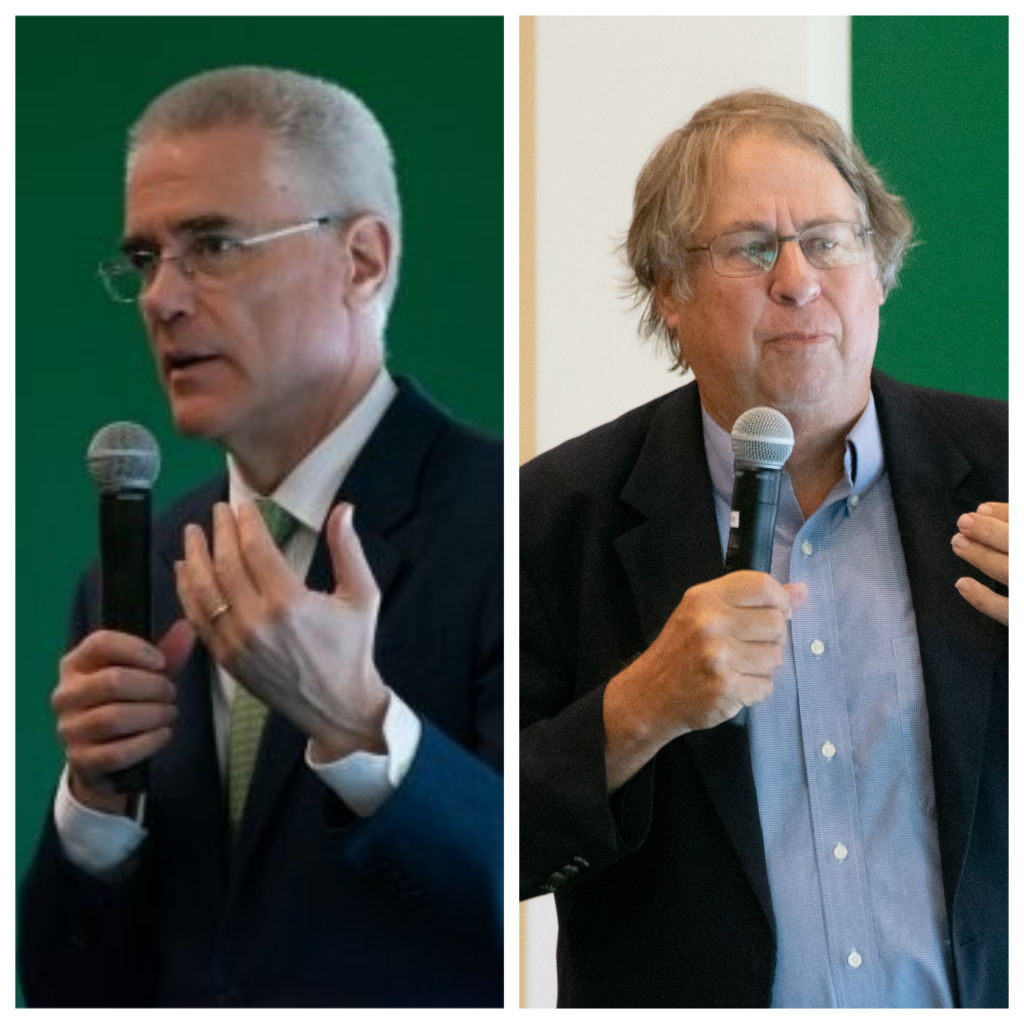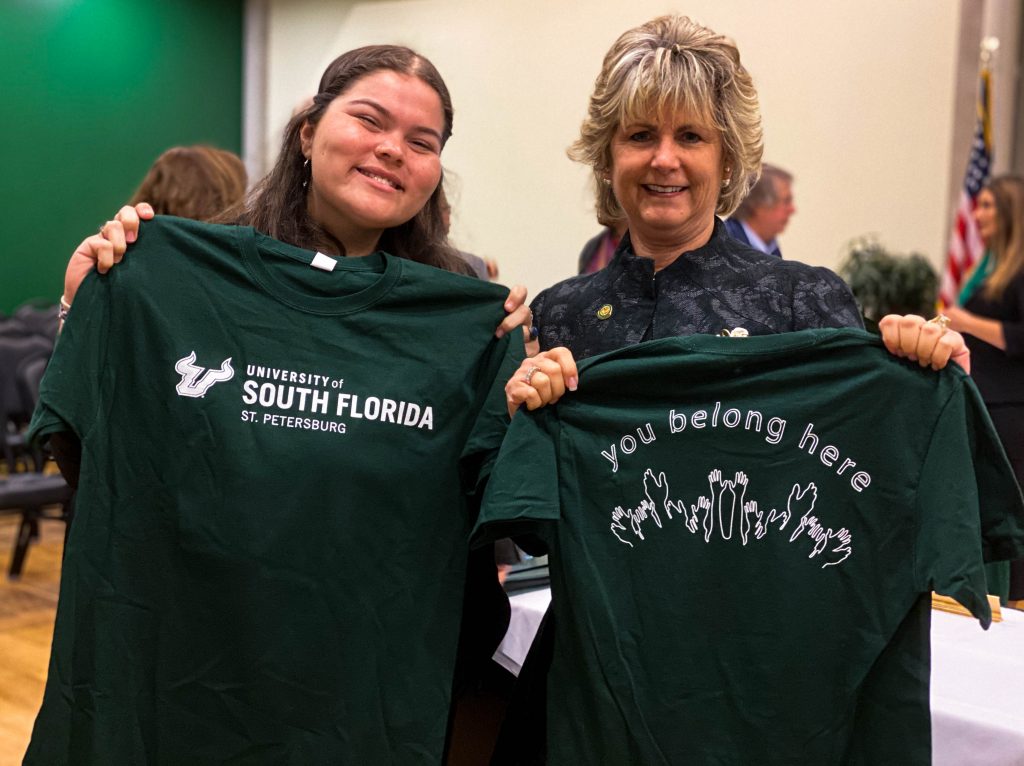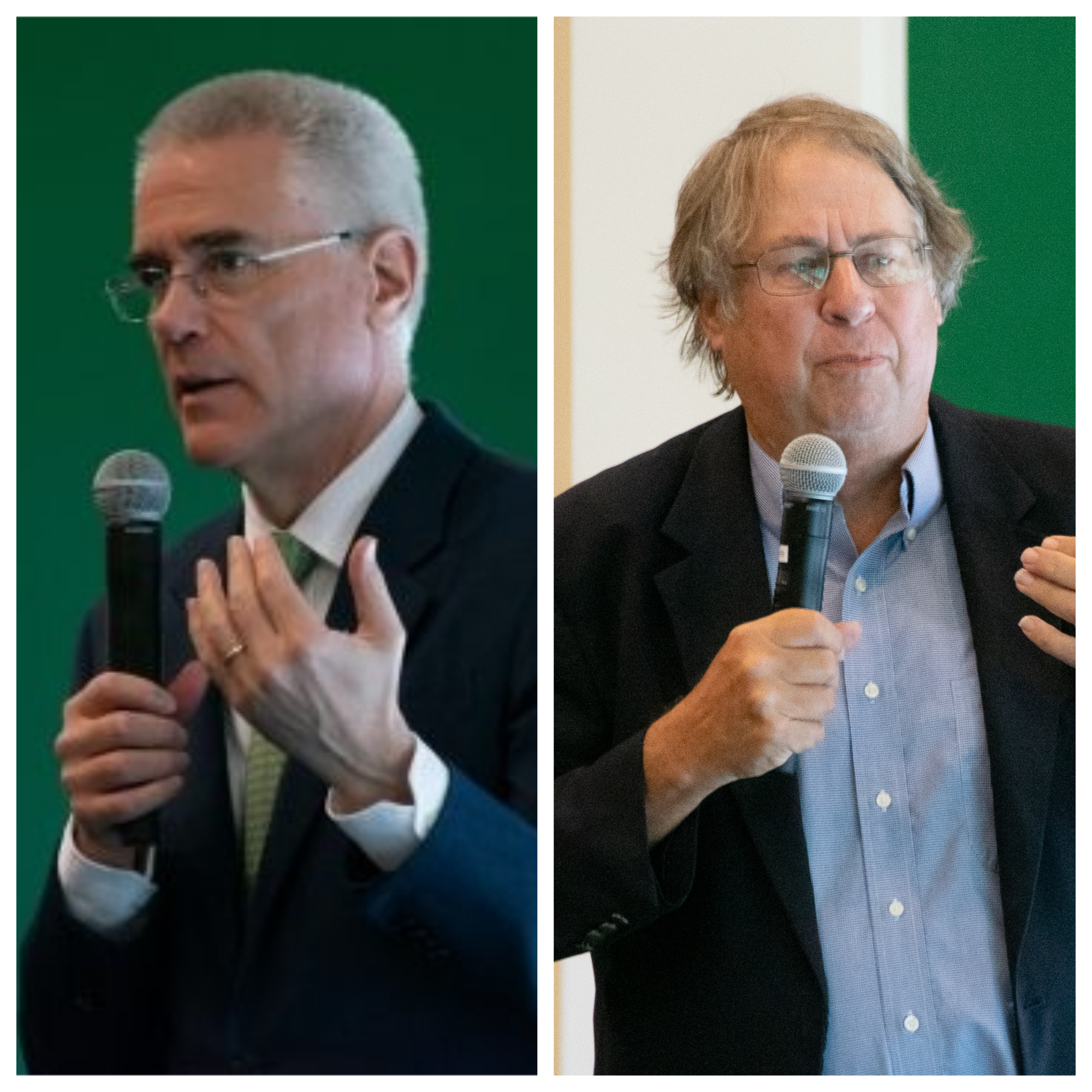
Jonah Hinebaugh | The Crow’s Nest
By Nancy McCann
Only three months after USF system President Steve Currall presented a consolidation plan that won praise in St. Petersburg, his administration is floating organizational charts that appear to backtrack on his promises.
The charts, which were presented by the Currall administration on Jan. 9, caught some St. Petersburg campus leaders by surprise.
The proposed administrative structure looks like a model that was championed by Currall’s predecessor, Judy Genshaft, but then abandoned last fall amid fierce opposition from Pinellas County legislators and allies of the St. Petersburg campus.
Professor Ray Arsenault, the campus’ most outspoken advocate on consolidation issues, told the St. Petersburg Campus Board on Jan. 23 that the new charts don’t reflect “some of the ongoing negotiations and agreements that we thought had been made and the legislation that guarantees us branch campus status.”
He won quick agreement from Stephanie Goforth, a Pinellas banker who chairs the Campus Board and serves on the USF system Board of Trustees.
“Let me assure this group that your Campus Board and Board of Trustees absolutely agree with you,” said Goforth. “We have all just seen this most recent draft so we are hoping it’s not a strategy.
“I know that I am also having these conversations and taking this to the (trustees’) strategic (initiatives) committee to ask questions about clarifications of the roles – dotted lines versus solid lines – so we will have more clarification on this.”
Two days later, Currall seemed to be retreating.
In a statement to The Crow’s Nest on Jan. 25, Currall called the new charts “a work in progress that will continue to be refined before USF submits a comprehensive substantive change prospectus document” to the regional accrediting agency by March 15.
“As our discussions continue, we fully intend to follow the framework of the plan announced in October,” said Currall. “We remain committed to using it as a guide for finalizing more details regarding alignment of academic programs, departments and colleges and other critical support structures.” (See Currall’s full statement below.)
The Crow’s Nest asked Arsenault for his reaction to this explanation.
“The mistakes they have made in the organizational charts have caused needless confusion and heartache,” he said.
“It’s just not acceptable. I feel like we are just being tossed and turned in the wind.
“I’m happy they say they will change it to where it’s supposed to be. I will believe it when I see it.” (See Arsenault’s full comments below.)
Confusion abounds
The dust-up is just the latest development in the confused rush to consolidation, which the Legislature set in motion in January 2018 with language buried in a 52-page bill that – once enacted two months later – ended the independent accreditation of St. Petersburg and Sarasota-Manatee and rolled the three USF system campuses into one.
As the July 1 effective date of consolidation grows nearer, uneasiness and confusion abound in St. Petersburg.
Speaking as president of the USF St. Petersburg Faculty Senate, Arsenault told the Campus Board that “there is still a tremendous amount of anxiety and concern” about how the consolidation process will work its way to completion regarding “equity” in issues like faculty teaching loads, research resources and salaries.
Atop the list of concerns is the amount of authority that will be vested in Regional Chancellor Martin Tadlock.
In the most recent organizational charts, no academic or student success personnel would report directly to him.
“All the solid lines (for reporting relationships) in the charts seem to go toward Tampa,” Arsenault said.
When Currall succeeded Genshaft on July 1, he took pains to assure the St. Petersburg campus and its allies in the community that the campus would continue to prosper under consolidation.
He called St. Petersburg “a gem and a jewel” and assured the editorial board of the Tampa Bay Times that fears that the campus would lose its autonomy and identity “are not well-founded.”
Yet the “preliminary blueprint” for consolidation that he unveiled on Sept. 10 would have wrested control of academic and student affairs from Tadlock and Sarasota-Manatee Regional Chancellor Karen Holbook and moved those responsibilities to Tampa.
That plan “turns Martin into a glorified development officer,” Arsenault said at the time.
Under pressure from the St. Petersburg campus, key Pinellas legislators and local elected officials, Currall revised the plan about a month later.
The revisions were applauded by Arsenault, the Times, and Rep. Chris Sprowls, R-Palm Harbor, the chief legislative architect of consolidation and chairman of the powerful House Rules Committee.
The revisions spelled out “clear responsibility and accountability (i.e., ‘authority’) for academic and budgetary decisions” for Tadlock.
The plan said that responsibility and accountability would include “decision-making regarding branch campus academic programs, in collaboration with college deans and faculty members”; campus academic performance outcomes; assessing and planning future faculty needs and promotion decisions; providing equitable support services for all students, faculty and other personnel on branch campuses; proposing and implementing branch campus budgets; and leading daily branch campus operations.
Now, the newly released organizational charts have people scratching their heads.
They are reminiscent of Genshaft’s idea that St. Petersburg could be “somewhere in-between” a branch campus and a less prestigious instructional site – an approach that was seemingly laid to rest in October.
The charts the Currall administration released earlier this month were part of a two-volume, 164-page document titled “USF Consolidation: Academic and Student Success Implementation Handbook.”
The handbook was the focus of two private meetings of what the administration calls “university leaders.”
Attendance at the all-day meetings on Jan. 9 and 16 was by invitation only. According to a list provided by the Tampa administration, 163 of those leaders are based in Tampa, 10 in St. Petersburg and seven in Sarasota-Manatee.
Late last week, Tadlock assured his leadership team in an email that the organizational charts “will be revised to better align with” Currall’s prior plan and language added to state law last year by Sprowls and others that requires St. Petersburg and Sarasota-Manatee to be full branch campuses.

Nancy McCann | The Crow’s Nest
“They (the charts) are a work in progress, and they are not final until approved by the president and included in the documents sent to SACSCOC (the regional accrediting agency),” Tadlock wrote. “There are additional conversations coming next week that will result in changes to the organizational charts.”
In an interview with The Crow’s Nest after sending the email, Tadlock said that USF system Provost Ralph Wilcox, Sarasota-Manatee Regional Chancellor Holbrook and he will be making suggestions for revisions to the charts and clarifications in the text of the new consolidation handbook.
“Once we work through the revisions, I think we will be right where we need to be,” said Tadlock.
In one of the new organizational charts, Magali Michael, the dean of USF St. Petersburg’s College of Arts and Sciences, is shown as a campus dean reporting to Eric Eisenberg, the college dean in Tampa. The chart shows no one reporting directly to her.
Arts and Sciences is the largest college on the St. Petersburg campus.
“No matter what final organizational structures are in place, we are committed to continue offering students the high level of education they expect as well as to grow the programs distinct to the St. Pete campus,” Michael wrote to The Crow’s Nest on Jan. 25.
Tadlock agrees.
“Independent of the organizational charts that are required for a few reasons, we will still have a leadership team that will be responsible for what happens on this campus,” he said. “That’s the way the real world works.”
A packed town hall
The organizational structure of a consolidated university is not the only concern in St. Petersburg.
In formal meetings and informal conversations, some St. Petersburg faculty and staff members complain they are getting conflicting information about what will be expected of them once consolidation takes effect on July 1.
At a standing-room-only town hall meeting on campus Jan. 23, some faculty and staff talked about problems of trust and betrayal. They complained that they have not been consulted on issues that affect them and they don’t want to be talked down to by the Tampa campus.
“What I find lacking is a sense of protection for staff,” said Donna Knudsen, USF St. Petersburg’s director of graduate studies.
“Even though our environment here on this campus makes us feel very comfortable to be outspoken and have our voices heard, I think there’s a lot of trepidation I hear from my colleagues that are staff members…as to whether or not there’s a bit of danger that comes with being outspoken.”
“While faculty and staff have unions to fall back on,” Knudsen said, “I feel like we might have an opportunity to do something at this juncture with staff around USF to feel more comfortable about expressing their points of view.”
Dylan Hart contributed to this report.
Currall: ‘A work in progress’
The Crow’s Nest asked USF system President Steve Currall to respond to concerns about the consolidation process that were voiced Jan. 23 by professor Ray Arsenault, who is chairman of the USF St. Petersburg Faculty Senate.
This was Currall’s response on Jan. 25:
“The academic and student success handbooks on consolidation are a work in progress that will continue to be refined before USF submits a comprehensive substantive change prospectus document to our accrediting organization by March 15.
“When the handbooks were distributed earlier this month, it was made clear that the materials are ‘living documents’ and not final.
“As our discussions continue, we fully intend to follow the framework of the plan announced in October that had the united support of USF St. Petersburg Regional Chancellor Martin Tadlock, USF Sarasota-Manatee Regional Chancellor Karen Holbrook and myself.
“Our plan was met with overwhelmingly positive feedback and we remain committed to using it as a guide for finalizing more details regarding alignment of academic programs, departments and colleges and other critical support structures.
“Though consolidation is a complex process, we are confident a structure will be implemented that balances the need for USF to comply with both accreditation standards and state law.”
The Crow’s Nest also asked Currall if the USF administration had shared the latest consolidation handbook and organizational charts with state Rep. Chris Sprowls, R-Palm Harbor, and other members of the Pinellas legislative delegation.
Here was Currall’s response:
“USF leadership is in regular contact with members of our state legislature on key university priorities and issues important to the Tampa Bay region.
“The academic and student success handbooks are a work in progress that will continue to be refined until we have a final version.
“We look forward to sharing updates with all of our stakeholders, including legislators from Hillsborough, Manatee, Pinellas and Sarasota Counties, as we approach our March 15 deadline to submit a substantive change prospectus document to our accrediting organization.”
Arsenault: ‘Needless confusion’
The Crow’s Nest asked professor Ray Arsenault to respond to Currall’s explanation.
Here is what he said in an interview:
“The mistakes they have made in the organizational charts have caused needless confusion and heartache. It’s just not acceptable.
“I feel like we are just being tossed and turned in the wind.
“After all the hard work that has been put into the consolidation process, this apparent backsliding is causing needless confusion.
“With all the talk about community principles, the most important is that we need to build trust. We have what psychologists call institutional anxiety and it brings out the worst in everyone.
“We need to build trust, and this type of mistake does not build trust.
“The Campus Board was kind of mystified the other day. People are exhausted with this consolidation process. Anything that can be done to smooth the way to the end of this process should be put in motion.
“I’m happy they say they will change it (the organizational structure) to where it’s supposed to be. I will believe it when I see it.
“The whole state of our campus hangs in the balance.”



